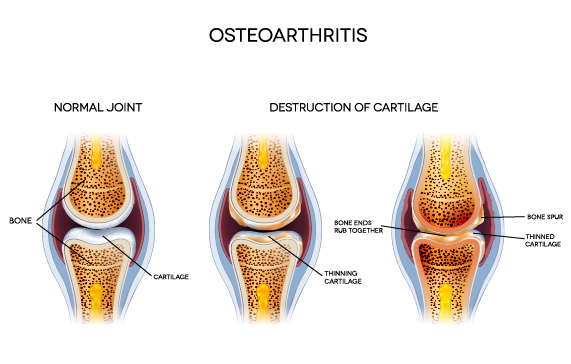How Can We Be Proactive in Fighting the Common Causes of Osteoarthritis?
Osteoarthritis (OA) is known as a degenerative joint disease, which means it will get worse as time progresses. It is the most commonly reported form of disease resulting from arthritis and it affects millions of people worldwide. While the symptoms can be managed, the damage to the joints is not reversible. OA will develop when the protective cartilage that cushions your bones wears down over time and it will cause damage to any joint in the body. Osteoarthritis will occur most often in areas of extreme importance: your hands, knees, hips, and spine.
Living with Osteoarthritis
Cartilage is our body’s buffer zone. It lets your joints move smoothly and when that cartilage begins to break down, your bones end up rubbing together when you move. In turn, the friction it creates will cause inflammation, pain, and stiffness. OA can cause changes in the components that hold the joint together and are responsible for attaching muscle to bone. It is also common for OA to cause inflammation of the joint lining. When you experience these symptoms, it can make it extremely uncomfortable to take part in day-to-day activities and over time they can cause serious suffering and irreversible damage.
Many Americans are affected with this debilitating disease and as of late it is all too common to find yourself headed towards joint replacement surgery. It can take six months to a full year to recover, and even then, the joints rarely feel the same as they did before the surgery. Not only that, the wearing away of the joint surface may become a problem again 15 to 20 years down the line.

Laying the Groundwork for Change
Although there are quite a few causes of osteoarthritis that are out of our control, there are lifestyle changes that can reduce the risk of developing OA. At South Miami Spine and Joint, we take those factors seriously because they are areas where we can truly affect change. By slowing the progression of the disease and improving joint function, we’re able to create a big impact. Those changes allow us to alleviate the discomfort you are feeling and put you in a position to lead the healthier, active lifestyle you have been searching for.
Give us a call; our medical staff is passionate about superior care and they are knowledgeable about how to fight the symptoms of OA through lifestyle choices. In the meantime, take a moment to learn about the common causes of osteoarthritis and what steps you can take to help minimize the impact it has on your life.
How Will I Know?
Lets start by focusing on a factor that simply does not get enough attention. How do you know if you have the disease? When will you know if it is time to go to the doctor? If you have joint pain, tenderness, loss of flexibility, or stiffness that just will not go away and even seems to worsen… then it is time to make an appointment. More importantly, if you find that you are asking yourself these questions, then you owe it yourself to see your doctor and review the state of your health.
Because the most common causes of degenerative joint disease (OA) are preventable, it is important to not forget that the long term effects, while not reversible, are manageable. The sooner you are making the right lifestyle choices, the better off your long-term health will be.
Risk Factors and How to Counter Them
Gender
Women are more likely to develop osteoarthritis, though it is not clear why. Hormonal differences between men and women may play a role in the development of osteoarthritis. Postmenopausal women have an increased risk of developing arthritis and this has been linked to the decrease in estrogen during this time. It is extremely important for women to understand these increased risk factors and develop a plan that will help to minimize the risk and protect themselves from developing OA.
Obesity
The true impact of obesity on the development of knee osteoarthritis has only recently become clear. Studies conducted by the Medical Research Council’s Epidemiology Resource Center at Southampton University concluded for the first time that the risk of knee osteoarthritis increases progressively throughout the Body Mass Index (BMI) categories. These studies show that compared to someone of normal weight, an obese person with a BMI of 36 or more are 14 times more likely to develop knee osteoarthritis. They also have at least five times the risk of developing osteoarthritis in both knees after the disease has developed in one knee.
Along with causing OA to develop, long term obesity increases the level of pain and disability while also reducing the effectiveness of pain-relieving drugs. As a result, the need for joint replacement surgery becomes even more urgent, particularly as far as women are concerned. Unfortunately, research shows that nearly 50 percent of obese patients will have a poor outcome from joint replacement surgery compared to less than 10 percent of those at a healthy weight. Of all the preventable factors, obesity is without a doubt, the single biggest cause of osteoarthritis in weight-bearing joints. The earlier someone becomes overweight or obese, the greater the risk of developing osteoarthritis.
Age
Arthritis is a frequent problem for older adults. The likelihood of developing OA will increase over time and it is important to remain active and aware of your body’s needs. Swimming and low-to-moderately paced walks are both great activities that put minimal pressure on your joints. Those activities paired with daily stretching will help you preserve your balance and will protect against decreased motor coordination. It will also help to minimize your risk for injury from potential falls.
At South Miami Spine and Joint, we offer individualized physical therapy sessions, and chiropractic adjustments, both of which can help improve your balance and coordination. Also, it is important to focus on good nutrition and exercise so you can strengthen the muscles and decrease the risks associated with aging. Our staff is on hand and available to customize a plan specific to your needs. Their knowledge, combined with your desire to improve your health, will improve your odds and reduce the likelihood of developing OA. You can call us at (305) 595-1095 to discuss options that will minimize your risk and prioritize your overall health.
Family Genetics
Some things are just inherited through our family traits and the tendency to develop osteoarthritis is one of those. It is hereditary, and you are more likely to suffer from OA symptoms if your parents, grandparents, or siblings have the condition. OA tends to run in the family, especially if you have genetic joint defects. If your relatives have symptoms of joint pain, get the details before making a doctor’s appointment. Diagnosis of arthritis relies heavily on medical history as well as a physical examination. Learning about your family’s health history can help your doctor create the right treatment plan for you.
Reversing the Process with Health Eating & Proper Exercise
We recommend visiting Go4Life, a campaign from the National Institute on Aging. It is designed to help you fit exercise and physical activity into your daily life. Motivating older adults to become physically active for the first time, returning to exercise after a break in their routines, or building more exercise and physical activity into weekly routines are the essential elements of Go4Life. Go4Life offers exercises, motivational tips, and free resources to help you get ready, start exercising, and keep going. The Go4Life campaign includes an evidence-based exercise guide in both English and Spanish, an exercise video, an interactive website, and a national outreach campaign. The National Institute of Aging is a government agency that operates under the umbrella of the U.S. Department of Health and Human Services.
Joint Injuries
Past injuries to your joints can increase your risk and leave you prone to the common causes of osteoarthritis. Even injuries that occurred many years ago and have seemingly healed can increase the likelihood of developing OA.
This is known as post-traumatic arthritis. It affects about 5.6 million people in the United States; causing approximately 12% of osteoarthritis of the hip, knee, and ankle. It is defined by the wearing out of a joint that has had any past physical injury. It could be from a prior sports injury, a fall, a motor vehicle accident, or any other sources of trauma. Such injuries can damage the cartilage and bone, changing the mechanics of the joint and making it wear out more quickly. The deterioration is accelerated by continued stress, injury, or excess body weight and the symptoms are likely to manifest through joint pain, swelling, fluid accumulation in the joint as well as a decreased tolerance for walking, sports, stairs, and other activities that put stress on the joint.
As a whole, the most important factor towards limiting your potential risk regarding the common causes of osteoarthritis is arming yourself with knowledge., and taking action. Understand the contributing factors and make a concerted effort to implement the activities necessary to combat degenerative joint disease (OA). It will go a long way towards bringing you success and will ensure you enjoy a healthy lifestyle as you get older.
Content Sources: The Mayo Clinic, Versus Arthritis – Arthritis Research Campaign UK, Cleveland Clinic, The National Aging Institute (NIA), Go4Life
Go4Life is registered trademark of the U.S. Department of Health and Human Services


